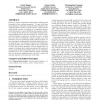Free Online Productivity Tools
i2Speak
i2Symbol
i2OCR
iTex2Img
iWeb2Print
iWeb2Shot
i2Type
iPdf2Split
iPdf2Merge
i2Bopomofo
i2Arabic
i2Style
i2Image
i2PDF
iLatex2Rtf
Sci2ools
SAC
2010
ACM
2010
ACM
Improving the efficiency of dynamic malware analysis
Each day, security companies see themselves confronted with thousands of new malware programs. To cope with these large quantities, researchers and practitioners alike have developed dynamic malware analysis systems. These systems automatically execute a program in a controlled environment and produce a report describing the program's behavior. During the last three years, the number of malware programs appearing each day has increased by a factor of ten, and this number is expected to continue to grow. To keep pace with these developments without causing even more hardware costs for operating dynamic analysis systems, we have developed a technique that drastically reduces the overall analysis time. Our solution is based on the insight that the huge number of new malicious files is due to mutations of only a few malware programs. To save analysis time, we suggest a technique that avoids performing a full analysis of the same polymorphic file multiple times. In an experiment condu...
| Added | 06 Dec 2010 |
| Updated | 06 Dec 2010 |
| Type | Conference |
| Year | 2010 |
| Where | SAC |
| Authors | Ulrich Bayer, Engin Kirda, Christopher Kruegel |
Comments (0)

